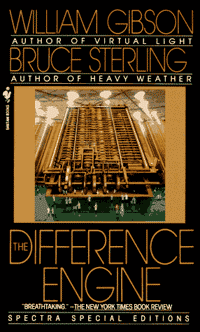 I feel like a bit of a crime dog, sniffing out the obscure cultural references. Not that this one was hard to find, sitting as it does on the very first page. And it's a pretty gratuitous mention, too - create an introductory tableau of an old woman on a balcony, and toss in a piece of fabric made by what was possibly the first industrial machine to run via pre-programming. A program on punch cards, no less! While the Jacquard loom has no feature in at least this first section of the book, it holds its own historical significance. Like, hey, maybe it was in on of the "revolution" part of the Industrial Revolution?
I feel like a bit of a crime dog, sniffing out the obscure cultural references. Not that this one was hard to find, sitting as it does on the very first page. And it's a pretty gratuitous mention, too - create an introductory tableau of an old woman on a balcony, and toss in a piece of fabric made by what was possibly the first industrial machine to run via pre-programming. A program on punch cards, no less! While the Jacquard loom has no feature in at least this first section of the book, it holds its own historical significance. Like, hey, maybe it was in on of the "revolution" part of the Industrial Revolution?
There are a few precursors to Joseph Marie Jacquard -- Bouchon, Falcon, and Vaucanson are the guys that created, respectively, a loom pattern using perforated paper, the first punch card mechanism, and a loom that would run automatically. As far as I can tell, Jacquard just rolled all those inventions into one magical machine: suddenly all the thinking (I think they call it craftsmanship) was gone from the "art" of weaving; the only human intervention required was the manpower of stepping on the treadle, and the occasional reloading of thread and program. This timeline spans from Bouchon's invention in 1725 to Jacquard's industrialization in 1801. According to one source, people rioted against the introduction of Falcon's punch-card looms -- you know how we have slick guild and union systems set up to console people with nice pensions when they get labelled as redundancies? I take it they didn't have those back in the day.
Anyways, it might make you feel better to know that when Jacquard introduced his loom to the French government, they liked it so much they declared it public property, essentially stealing his work, too. Really, I don't know why machines get the worst rep in this society.
- Allana
(Although I did see an episode of Northern Exposure last night where a piano-tuner comes into the bar and insists on fixing the old upright. Marilyn later notes that the D above middle C is flat; the piano-tuner retorts that Persian rug weavers always left one knot tied wrong - "otherwise, the rug would be perfect." But I do admit to a false sense of security whenever Northern Exposure gets clever.)
The Jacquard Loom.
Written by Allana on Sunday, April 04, 2010
Subscribe to:
Post Comments (Atom)




Hey, it's Vaucanson of duck fame!
ReplyDeleteI caught a mention of his name in the name of the Brotherhood of French Clackers, Les Fils de Vaucanson (page 28 in the mass-market paperback edition), and thought it was probably the same person.
Interesting how computation and artificial life were both interests of his. Those two things have been tied closely together since the very advent of computing, much further back than most people realize.
All this technology so far really did almost exist... you would just have had to nudge things a very little for it to have been made. If Charles Babbage had found better craftsmen, or had more time and money, the engine could have been built. Would the rest have flowed from that? Probably not, but the potential for all of it isn't as far away from possible as most science fiction scenarios are.
We;ll need to do a couple of posts about the Luddites and the anti-mechanical resistance as it exists in this book and as it existed in reality. I get the feeling that isn't so far off of true either.